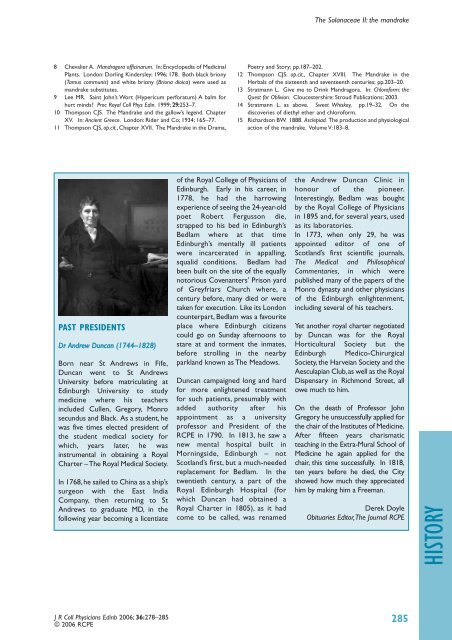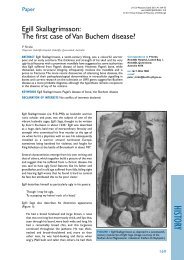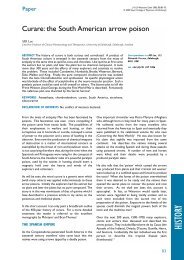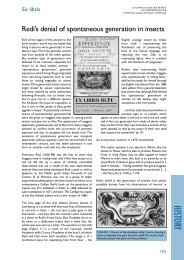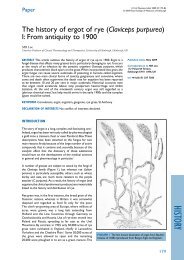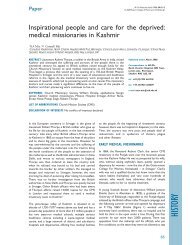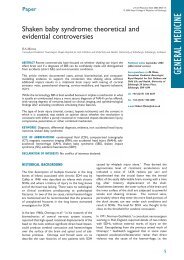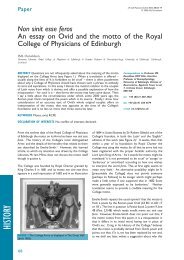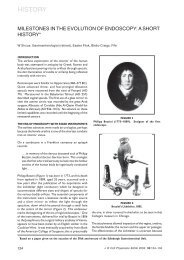The Solanaceae II: The mandrake (Mandragora officinarum); in ...
The Solanaceae II: The mandrake (Mandragora officinarum); in ...
The Solanaceae II: The mandrake (Mandragora officinarum); in ...
You also want an ePaper? Increase the reach of your titles
YUMPU automatically turns print PDFs into web optimized ePapers that Google loves.
8 Chevalier A. <strong>Mandragora</strong> <strong>offic<strong>in</strong>arum</strong>. In: Encyclopedia of Medic<strong>in</strong>al<br />
Plants. London: Dorl<strong>in</strong>g K<strong>in</strong>dersley; 1996; 178. Both black briony<br />
(Tamus communis) and white briony (Briona dioica) were used as<br />
<strong>mandrake</strong> substitutes.<br />
9 Lee MR. Sa<strong>in</strong>t John’s Wort (Hypericum perforatum) A balm for<br />
hurt m<strong>in</strong>ds? Proc Royal Coll Phys Ed<strong>in</strong>. 1999; 29:253–7.<br />
10 Thompson CJS. <strong>The</strong> Mandrake and the gallow’s legend. Chapter<br />
XV. In: Ancient Greece. London: Rider and Co; 1934; 165–77.<br />
11 Thompson CJS, op.cit., Chapter XV<strong>II</strong>. <strong>The</strong> Mandrake <strong>in</strong> the Drama,<br />
PAST PRESIDENTS<br />
Dr Andrew Duncan (1744–1828)<br />
Born near St Andrews <strong>in</strong> Fife,<br />
Duncan went to St Andrews<br />
University before matriculat<strong>in</strong>g at<br />
Ed<strong>in</strong>burgh University to study<br />
medic<strong>in</strong>e where his teachers<br />
<strong>in</strong>cluded Cullen, Gregory, Monro<br />
secundus and Black. As a student, he<br />
was five times elected president of<br />
the student medical society for<br />
which, years later, he was<br />
<strong>in</strong>strumental <strong>in</strong> obta<strong>in</strong><strong>in</strong>g a Royal<br />
Charter – <strong>The</strong> Royal Medical Society.<br />
In 1768, he sailed to Ch<strong>in</strong>a as a ship’s<br />
surgeon with the East India<br />
Company, then return<strong>in</strong>g to St<br />
Andrews to graduate MD, <strong>in</strong> the<br />
follow<strong>in</strong>g year becom<strong>in</strong>g a licentiate<br />
J R Coll Physicians Ed<strong>in</strong>b 2006; 36:278–285<br />
© 2006 RCPE<br />
of the Royal College of Physicians of<br />
Ed<strong>in</strong>burgh. Early <strong>in</strong> his career, <strong>in</strong><br />
1778, he had the harrow<strong>in</strong>g<br />
experience of see<strong>in</strong>g the 24-year-old<br />
poet Robert Fergusson die,<br />
strapped to his bed <strong>in</strong> Ed<strong>in</strong>burgh’s<br />
Bedlam where at that time<br />
Ed<strong>in</strong>burgh’s mentally ill patients<br />
were <strong>in</strong>carcerated <strong>in</strong> appall<strong>in</strong>g,<br />
squalid conditions. Bedlam had<br />
been built on the site of the equally<br />
notorious Covenanters’ Prison yard<br />
of Greyfriars Church where, a<br />
century before, many died or were<br />
taken for execution. Like its London<br />
counterpart, Bedlam was a favourite<br />
place where Ed<strong>in</strong>burgh citizens<br />
could go on Sunday afternoons to<br />
stare at and torment the <strong>in</strong>mates,<br />
before stroll<strong>in</strong>g <strong>in</strong> the nearby<br />
parkland known as <strong>The</strong> Meadows.<br />
Duncan campaigned long and hard<br />
for more enlightened treatment<br />
for such patients, presumably with<br />
added authority after his<br />
appo<strong>in</strong>tment as a university<br />
professor and President of the<br />
RCPE <strong>in</strong> 1790. In 1813, he saw a<br />
new mental hospital built <strong>in</strong><br />
Morn<strong>in</strong>gside, Ed<strong>in</strong>burgh – not<br />
Scotland’s first, but a much-needed<br />
replacement for Bedlam. In the<br />
twentieth century, a part of the<br />
Royal Ed<strong>in</strong>burgh Hospital (for<br />
which Duncan had obta<strong>in</strong>ed a<br />
Royal Charter <strong>in</strong> 1805), as it had<br />
come to be called, was renamed<br />
<strong>The</strong> <strong>Solanaceae</strong> <strong>II</strong>: the <strong>mandrake</strong><br />
Poetry and Story; pp.187–202.<br />
12 Thompson CJS. op.cit., Chapter XV<strong>II</strong>I. <strong>The</strong> Mandrake <strong>in</strong> the<br />
Herbals of the sixteenth and seventeenth centuries; pp.203–20.<br />
13 Stratmann L. Give me to Dr<strong>in</strong>k <strong>Mandragora</strong>. In: Chloroform: the<br />
Quest for Oblivion. Cloucestershire: Stroud Publications; 2003.<br />
14 Stratmann L. as above. Sweet Whiskey, pp.19–32. On the<br />
discoveries of diethyl ether and chloroform.<br />
15 Richardson BW. 1888. Asclepiad. <strong>The</strong> production and physiological<br />
action of the <strong>mandrake</strong>. Volume V:183–8.<br />
the Andrew Duncan Cl<strong>in</strong>ic <strong>in</strong><br />
honour of the pioneer.<br />
Interest<strong>in</strong>gly, Bedlam was bought<br />
by the Royal College of Physicians<br />
<strong>in</strong> 1895 and, for several years, used<br />
as its laboratories.<br />
In 1773, when only 29, he was<br />
appo<strong>in</strong>ted editor of one of<br />
Scotland’s first scientific journals,<br />
<strong>The</strong> Medical and Philosophical<br />
Commentaries, <strong>in</strong> which were<br />
published many of the papers of the<br />
Monro dynasty and other physicians<br />
of the Ed<strong>in</strong>burgh enlightenment,<br />
<strong>in</strong>clud<strong>in</strong>g several of his teachers.<br />
Yet another royal charter negotiated<br />
by Duncan was for the Royal<br />
Horticultural Society but the<br />
Ed<strong>in</strong>burgh Medico-Chirurgical<br />
Society, the Harveian Society and the<br />
Aesculapian Club,as well as the Royal<br />
Dispensary <strong>in</strong> Richmond Street, all<br />
owe much to him.<br />
On the death of Professor John<br />
Gregory he unsuccessfully applied for<br />
the chair of the Institutes of Medic<strong>in</strong>e.<br />
After fifteen years charismatic<br />
teach<strong>in</strong>g <strong>in</strong> the Extra-Mural School of<br />
Medic<strong>in</strong>e he aga<strong>in</strong> applied for the<br />
chair, this time successfully. In 1818,<br />
ten years before he died, the City<br />
showed how much they appreciated<br />
him by mak<strong>in</strong>g him a Freeman.<br />
Derek Doyle<br />
Obituaries Editor,<strong>The</strong> Journal RCPE<br />
285<br />
HISTORY


